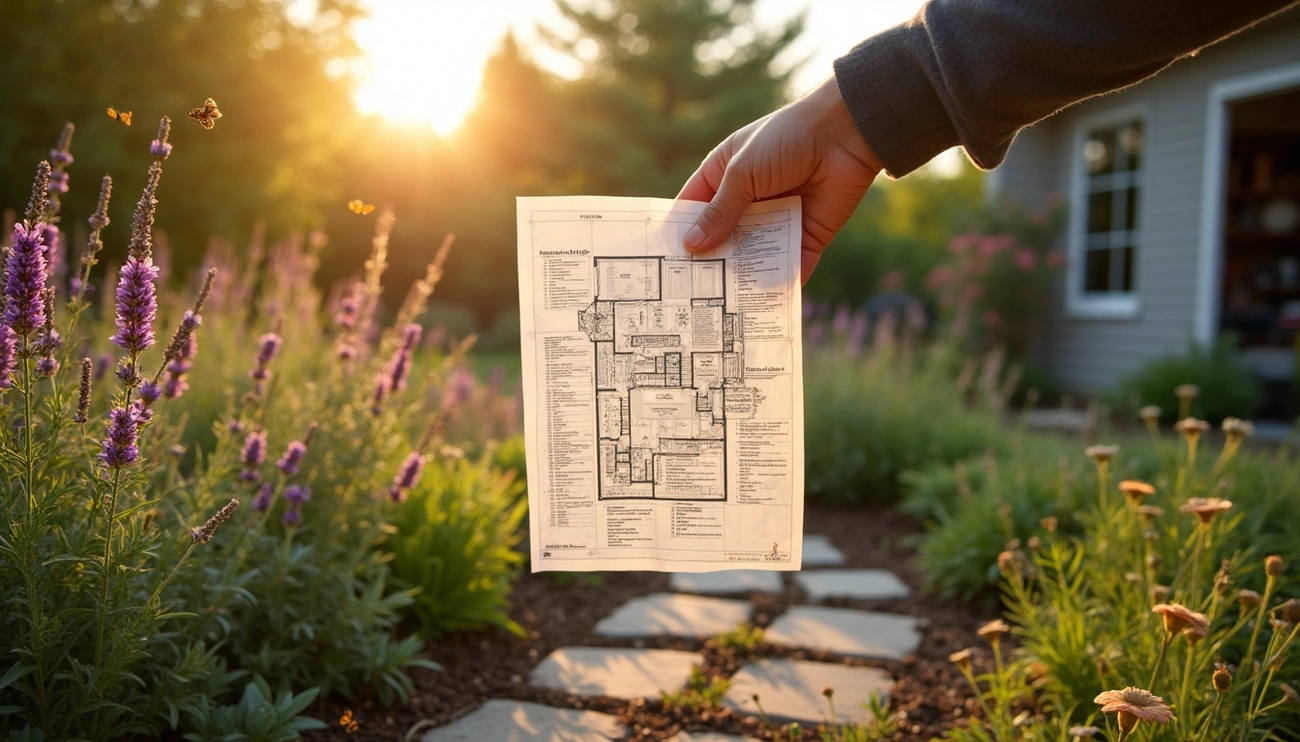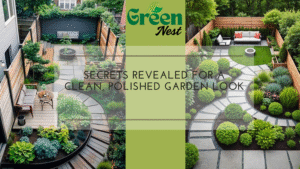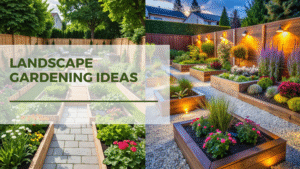Garden Plans Secrets: What Expert Gardeners Don’t Tell You About Spring 2025
If you’re looking to create beautiful perennial garden plans or practical vegetable garden plans, you’re in the right place. By incorporating perennial flowers that return year after year, we can build gardens that bloom with minimal care. Additionally, thoughtful garden layout considerations, such as ensuring growing areas between paths don’t exceed 4 feet in width, can make maintenance significantly easier.
In this guide, we’ll share what expert gardeners typically keep to themselves. The demand for native plants is skyrocketing as more gardeners recognize their numerous benefits, and we’re adapting to the challenges of a changing world by embracing innovative approaches. From soil health secrets to companion planting strategies, we’ll explore how to create garden plans that not only look stunning but also support local pollinators and thrive with less intervention from us.
Start with a Garden Walk: What Experts Look For
Image Source: Bonnie Plants
Table of Contents
Expert gardeners don’t randomly place plants in their yards—they begin with a methodical garden walk to assess key conditions. This critical first step informs every decision in your garden plans, from plant selection to optimal layout. Let’s explore what the professionals look for when evaluating a space.
Check soil health and drainage
The cornerstone of any good garden is healthy soil. Before purchasing a single plant, grab a handful of soil and perform the squeeze test: form a ball in your hand and gently poke it with your finger. If it crumbles easily, your soil likely has good tilth and workability. If it remains in a tight ball, you may need amendments before planting.
Professional gardeners always check for drainage issues since soggy roots lead to unhappy plants. To test drainage properly:
- Dig a hole about 12 inches deep
- After adding water, see how quickly it drains.
- If water remains after 24 hours, your soil has poor drainage and requires amendments before planting
Quality soil should contain plenty of organic matter and support beneficial organisms like earthworms. During your garden walk, dig up a chunk of soil 6 inches deep and count the worms—five is ideal, though three still indicates reasonably healthy soil [1]. Furthermore, rich soil should have an earthy smell similar to compost; the absence of smell indicates low biological activity [2].
Observe sun and shade patterns
Sunlight exposure ranks among the most critical factors in plant success, yet many beginning gardeners overlook its complexity. In North Carolina’s Extension Gardener Plant Toolbox, plants are classified into four light categories: full sun (6+ hours of direct sunlight), partial shade (2-6 hours), deep shade (less than 2 hours), and dappled sunlight (filtered through tree canopies) [3].
To properly map sun patterns, walk your yard hourly throughout a day, recording where light falls and shadows form. Morning sun differs significantly from afternoon exposure—eastern areas receive gentler morning light while western exposures face hotter, more intense afternoon rays. Consequently, even “full sun” plants may struggle in July and August afternoon heat [3].
For vegetable garden plans, most edibles require at least eight hours of full sun, though some leafy greens can manage with six hours. Herbs typically need six hours, whereas berries generally demand eight hours of direct sunlight [3]. Creating a sun map on paper can help visualize these patterns and inform your garden layout decisions.
Identify microclimates in your yard
Even small yards contain microclimates—localized areas with unique growing conditions that might differ significantly from the rest of your space. These variations make the difference between thriving plants and struggling ones.
Microclimates form due to several factors: topography affects solar radiation and water flow, with cold pockets often forming at the bottoms of slopes [3]. Structures like walls, fences, and garden sheds impact wind patterns and heat retention. Heat is absorbed by decks, stone, and pavement during the day and released at night, forming “heat sinks” that have an impact on surrounding plants [4].
The direction areas face (exposure) dramatically influences growing conditions. Eastern exposures receive morning sun with less wind and typically remain moister.Western exposures becoming hotter, windier, and drier as they face the afternoon sun. Northern exposures stay shady and cooler, while southern exposures enjoy warmth and sunshine even in winter, creating longer growing seasons [3].
Taking time to identify these conditions will fundamentally improve your garden plans. Professional gardeners recognize that these detailed observations—rather than arbitrary design choices—determine the ultimate success of any garden project.
Designing the Layout: Beyond the Obvious
Image Source: Pretty Purple Door
Beyond basic garden planning lies a realm of strategic design elements that professional gardeners understand intuitively. These subtle factors can make the difference between a garden that thrives and one that struggles throughout the seasons.
Why most gardeners ignore wind direction
Surprisingly, most home gardeners overlook wind patterns when designing their garden layout. Nevertheless, wind dramatically affects plant health, garden comfort, and even heating costs. A properly positioned windbreak can reduce wind speed for a distance of up to 30 times the windbreak’s height [5]. This protection creates a calmer microclimate where plants flourish without constant stress.
Wind chill doesn’t just affect humans—it impacts plants too. The wind chill drops to -24°F if the outdoor temperature is 10°F and the wind speed is 20 miles per hour. [5]. Such conditions drastically increase plant stress and can damage delicate specimens.
For maximum protection, experts recommend:
- Setting up windbreaks two to five times as far away from your house as the mature height of the trees
- Using low-crown plants in conjunction with thick evergreen trees
- Placing windbreaks at right angles to prevailing winds
- Aiming for 30-50% permeability rather than solid barriers, which create turbulent airflow
Indeed, semi-permeable barriers like latticed fences or staggered plantings work better than solid walls because they filter wind rather than creating disruptive turbulence on the leeward side.
The secret to spacing for airflow and disease prevention
Proper plant spacing represents one of the most underappreciated aspects of successful garden plans. Above all, adequate spacing prevents disease by allowing better air circulation, which keeps foliage dry and reduces the risk of fungal diseases [6].
In essence, overcrowded plants provide viruses the perfect environment in which to grow. When plants grow too close together, humidity levels rise within the canopy, creating perfect conditions for diseases like powdery mildew and botrytis blight [7]. Furthermore, densely packed plants prevent thorough spray coverage when treatments become necessary.
By using just enough energy to overcome friction and turbulence, this method guarantees that air travels in a consistent path . According to research, air circulation of 50–100 feet per minute maintains leaf temperatures at night that are nearly equal to ambient air, avoiding condensation that harbors disease-causing organisms.
To achieve optimal airflow:
- Space plants according to mature size recommendations
- In order to give the leaves enough time to dry before sunset, water them early.
- Prune selectively to open plant centers
- Arrange rows in the direction of prevailing summer breezes
Using garden shed plans to optimize tool access
A thoughtfully positioned garden shed transforms garden maintenance from chore to pleasure. Firstly, consider accessibility—your shed should be easily reachable without trudging through mud or obstacles [3].
Meanwhile, security concerns suggest placing the shed where it’s visible from your house to deter potential intruders [3].Furthermore, rather of taking over your environment, a garden shed should enhance it.
From a practical standpoint, place your shed on level, well-drained ground. Avoid low-lying areas that collect water, as moisture leads to wood rot, mold, and mildew over time [3]. A crushed stone foundation provides excellent drainage and stability.
For wind protection, shelter your shed from prevailing winds when possible, and ensure it has proper ventilation to prevent humidity buildup [8]. This ventilation helps maintain both the structure and its contents.
In the end, the location of your garden shed should correspond with its main function. If storing garden tools, position it near your growing areas. This strategic placement minimizes trips back and forth while carrying heavy equipment, making gardening more efficient and enjoyable.
Choosing Plants Like a Pro
Image Source: The Spruce
Creating a garden that blooms continuously throughout the seasons requires strategic plant selection. Professional gardeners know that the right mix of plants makes all the difference in achieving a garden that’s both beautiful and manageable.
How experts mix perennials and annuals
The secret to a garden that blooms from spring to fall lies in thoughtful plant combinations. Perennials typically flower for 4-8 weeks before going out of bloom for the year [4]. Although they return annually, this limited bloom period creates color gaps that can leave your garden looking sparse.
To solve this problem, I always tuck annual flowers into any empty spots in my perennial garden plans. Annuals provide constant color throughout the summer, in contrast to perennials [4]. For cooler spring weather, try pansies, dusty miller, and snapdragons. As temperatures rise, switch to heat-loving annuals like zinnias, marigolds, and verbena [4].
Secrets to building a low-maintenance perennial garden plan
For a truly sustainable garden, start by grouping plants with similar water and light requirements together—a practice called hydrozoning [9]. This simple strategy dramatically reduces maintenance time and resource usage.
When selecting perennials, prioritize plants that are:
- Native to your region
- Hardy in your growing zone
- Resistant to common pests and diseases
- Adaptable to your soil conditions [10]
Proper soil preparation remains fundamental to perennial success. Incorporate organic matter 12 inches deep—approximately 3 cubic yards per 1,000 square feet [9]. This investment in soil health pays dividends through reduced maintenance for years to come.
Why native plants outperform trendy imports
Native plants have developed over thousands of years in your specific region, creating a perfect adaptation to local conditions [11]. Yet this advantage often gets overlooked in favor of trendy imports.
The ecological consequence is self-evident: popular non-native ginkgos only sustain five species of caterpillars, whereas native oak trees support over 500 [12]. Given that raising a single brood of chickadees requires 6,000 caterpillars, this difference becomes significant for supporting local wildlife [12].
Beyond ecological benefits, native plants require far less water once established [12]. Yards featuring native landscaping support 50% more native birds, 9 times more rare birds, 3 times more butterfly species, and twice as many native bees compared to conventional gardens [13].
Ultimately, native plants create a resilient foundation for your garden plans while saving you time, money, and resources.
The Hidden Power of Companion Planting
Image Source: Zero Waste Homestead
Companion planting stands as one of gardening’s most effective yet underutilized strategies. This traditional practice creates balanced ecosystems where plants protect each other through natural chemical secretions and strategic arrangements.
Vegetable garden plans that repel pests naturally
The classic “Three Sisters” method demonstrates companion planting’s effectiveness – corn provides support for beans, beans enrich soil with nitrogen, and squash shades the ground to prevent weeds [14]. This harmonious relationship creates a pest-resistant ecosystem without chemicals.
Strategic plant combinations in vegetable gardens can dramatically reduce pest problems. For instance, marigolds planted near tomatoes repel whiteflies [15], while nasturtiums act as “trap crops” that attract aphids away from valuable vegetables [16]. Radishes effectively draw flea beetles and cucumber beetles from other crops [17], protecting your primary harvest.
For maximum protection, create diversity in your garden. Research shows that mixed plantings confuse pests, making it harder for them to locate their preferred targets [15]. Additionally, garden layouts featuring multiple species create natural barriers that protect crops throughout the growing season [17].
Flower choices that boost pollination
Native flowers attract pollinators and increase garden yields at the same time. Beneficial insects like ladybugs and lacewings, which feed on garden pests, are drawn to plants like cosmos and zinnias [18]. Sweet alyssum draws in hoverflies whose larvae can consume up to 150 aphids daily [19].
For pollinator-friendly gardens, prioritize purple flowers like lavender and buddleja, as bees see purple more clearly than other colors [20]. Additionally, long-tongued bees are supported by tubular-shaped blossoms such as honeysuckle and foxgloves[20].
How to use herbs as natural protectors
Herbs create protective barriers through their strong aromas. Basil planted near tomatoes deters hornworms [21], while rosemary, thyme, and sage repel cabbage moths from brassicas [15].
Chives emit sulfur compounds that repel aphids and deer, making them ideal companions for leafy greens [22]. Oregano’s strong fragrance deters mosquitoes, aphids, and cabbage worms [22], therefore creating a natural pest barrier.
For targeted protection, position herbs strategically – surround tomatoes with basil, edge cabbage beds with thyme, and place mint near peas to deter aphids [21]. Subsequently, this intentional planting creates natural pest barriers while maintaining a beautiful garden design.
Timing and Seasonal Tricks Experts Use
Image Source: Template.net
What separates average gardens from extraordinary ones often comes down to timing. Professional gardeners understand that working with nature’s calendar yields better results than fighting against it.
Why fall prep is key to spring success
The foundation for spring success begins in autumn. Professional gardeners know fall is the perfect time for planting trees and shrubs before they enter dormancy. This timing allows roots to establish while the ground remains warm enough for development.
For best results, focus on these fall preparation steps:
- Clean beds thoroughly, removing all diseased plant matter to prevent spring recurrence
- Add compost and organic additions to the soil to nourish microorganisms
- Give spring-blooming bulbs enough time to grow roots—six weeks—before frost.
The work you do in fall dramatically reduces spring workload. By preparing beds before soil becomes waterlogged or hardened in winter, you’re essentially giving your spring garden a head start. Seizing on favorable fall ground conditions means less struggle when the growing season arrives.
The overlooked value of winter sowing
A practice that many gardeners overlook is winter seeding. This method uses protective vented containers placed outdoors during winter, allowing seeds to experience natural cold stratification. In essence, it mimics how seeds would naturally overwinter before germinating.
The benefits are substantial: it’s inexpensive, uses recycled materials, produces abundant seedlings, and doesn’t require indoor space or grow lights. Initially developed by Trudi Davidoff, winter sowing works best for native perennials between December and February, while cold-hardy annuals can be started from February through April.
Obviously, timing matters—sow too early in autumn and seedlings might not survive winter; wait too long and seeds may lack sufficient cold stratification time.
How to stagger bloom times for continuous color
Creating gardens with non-stop blooms requires understanding bloom sequences. For this purpose, combine plants that flower in different seasons without interfering with each other. As one plant declines, its neighbor should be preparing to shine.
Early season bulbs naturally go dormant after flowering, creating space for summer bloomers like catmint and asters to expand. Following those, incorporate late summer and fall blooming plants for season-extending color.
Instead of large single-variety plantings, garden in small groups so that areas out of bloom remain visually appealing. Plant closely enough that foliage intermingles, hiding bare spots when certain plants finish their show.
Conclusion
Thoughtful garden planning truly makes the difference between struggling with constant maintenance and enjoying a thriving outdoor space. Throughout this guide, we’ve uncovered professional gardening secrets most experts keep to themselves. From methodical garden walks that assess critical soil conditions to strategic layout designs that consider often-overlooked factors like wind patterns, these approaches transform ordinary gardens into extraordinary ones.
Additionally, mixing perennials with annuals creates continuous color while native plant selections drastically reduce maintenance needs. Remember how companion planting works as natural pest control – marigolds repel whiteflies, nasturtiums trap aphids, and aromatic herbs form protective barriers throughout your garden. These natural partnerships eliminate the need for chemical interventions while supporting local wildlife.
Without a question, one of the most effective gardening tools is still timing. Staggered bloom planning promotes year-round visual appeal, winter planting optimizes space and resources, and fall preparation sets the stage for spring success. Instead than working against the cycles of nature, these seasonal tactics complement them.
Therefore, start your garden planning now for Spring 2025. Take time to observe your specific conditions, consider strategic layouts, select appropriate plants, and embrace companion planting techniques. This intentional approach yields gardens that bloom abundantly while demanding less work from you. Most importantly, your thoughtfully planned garden will become a sustainable ecosystem supporting pollinators, beneficial insects, and local wildlife for years to come.
Whether you dream of perennial flower beds bursting with color or productive vegetable gardens that feed your family, these expert techniques provide the foundation for success. Your garden plan serves as more than just a blueprint—it becomes your roadmap to creating an outdoor space that brings joy throughout the seasons while working harmoniously with nature.
References
[1] – https://kellogggarden.com/blog/soil/how-to-tell-if-soil-is-good-with-8-simple-tests/
[2] – https://www.gardenorganic.org.uk/testing-the-health-of-our-soil
[3] – https://homesteadsupplier.com/blogs/news/where-to-put-shed-in-backyard?srsltid=AfmBOooJ_fhpThcQQW39KE2cKBuE5VrRqy4bRjgwGuIvekZNCbJAyOmL
[4] – https://costafarms.com/blogs/get-growing/mixing-perennials-with-annuals-to-make-colorful-combos?srsltid=AfmBOoo7PddTxcR9xu2PGJknc-O1z2no384-3f6ymVj-clnR1suudqWi
[5] – https://www.energy.gov/energysaver/landscaping-windbreaks
[6] – https://www.futuregarden.co.uk/expert-advice/the-importance-of-plant-spacing/
[7] – https://www.umass.edu/agriculture-food-environment/greenhouse-floriculture/greenhouse-best-management-practices-bmp-manual/disease-management
[8] – https://hintonbuildings.com/shed-placement-how-to-choose-the-best-location/?add-to-cart=240059&add-to-cart=134047&tve=true&tvet=23793&tcbf=75e9eb28b5&srsltid=AfmBOoqvjFmNXrY7Q4v3WopozOdd7nNdUPL2UyKn2iu9zwF_VcgGvNs2
[9] – https://extension.colostate.edu/topic-areas/yard-garden/perennial-gardening-7-402/
[10] – https://www.gardendesign.com/perennials/low-maintenance.html
[11] – https://www.usda.gov/about-usda/general-information/initiatives-and-highlighted-programs/peoples-garden/gardening-advice/why-native-species-matter
[12] – https://www.audubon.org/content/why-native-plants-matter
[13] – https://www.nhdfl.dncr.nh.gov/sites/g/files/ehbemt866/files/documents/why-native.pdf
[14] – https://www.motherearthgardener.com/organic-gardening/plan-for-less-pests-with-integrated-pest-management-zb0z1802/
[15] – https://www.almanac.com/companion-planting-guide-vegetables
[16] – https://extension.umn.edu/planting-and-growing-guides/companion-planting-home-gardens
[17] – https://zerowastehomestead.com/companion-gardening-guide-how-to-use-companion-planting-for-garden-pest-control/
[18] – https://www.farmstandapp.com/20176/companion-planting-strategies-for-pest-management/
[19] – https://www.gardendesign.com/plants/pollinators.html
[20] – https://bloominghaus.com/news/how-to-use-plants-for-natural-pest-control/
[21] – https://www.farmstandapp.com/20141/using-herbs-for-natural-pest-control-in-gardens/
[22] – https://www.gardenary.com/blog/the-best-herbs-to-plant-in-your-kitchen-garden-to-repel-garden-pests




